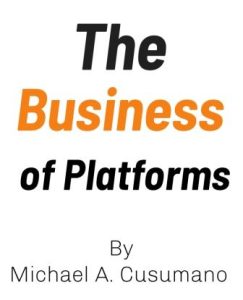Crossing The Chasm Summary
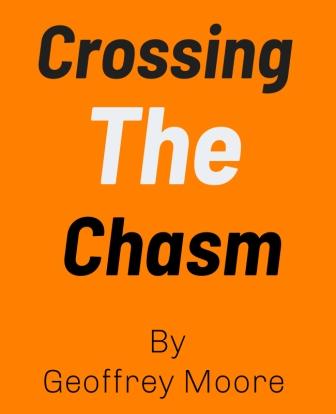
You either commit to a bold move into the mainstream market or you stay stuck—there’s no tiptoeing across.
Crossing The Chasm Summary
Glad you are here today!
Ever feel like your product gets early buzz but then… crickets? Like you’ve got a great idea, but can’t seem to break into the real market?
You’re not crazy—it’s a real problem, and Crossing the Chasm explains exactly why it happens and how to fix it.
This isn’t just another business book. It’s a field guide for turning cool tech into something the mainstream (majority) actually buys.
I’ve pulled together the key takeaways for you in this Crossing the Chasm summary, but honestly?
Once you get a taste, you’ll want to grab the full book. Let’s jump in!
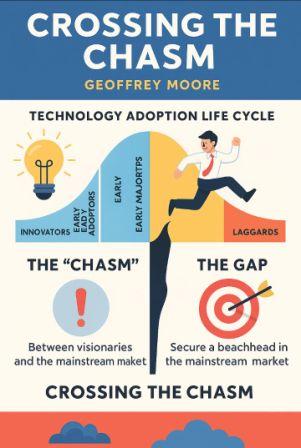
Why We Recommend this Book
This book will teach you how to design and deliver a “whole product” solution that pragmatist or risk-averse buyers trust.
It gives a step-by-step blueprint to anyone launching a new product can use.
The principles in this book apply to any new idea, innovation, or change initiative that must gain broader acceptance—from fintech to education to AI tools.
It shows you when and how to scale intelligently.
Crossing the Chasm has shaped the strategies of a lot of startups including :
- Apple: Early insights into launching personal computers beyond hobbyists.
- Salesforce: Used Moore’s framework to enter conservative B2B markets.
- VMware: Applied “whole product” and beachhead strategy to dominate virtualization.
- Dropbox and Slack: Used niche domination before mass expansion.
Questions to Ask Yourself before Reading Crossing The Chasm
- Have I struggled to move beyond early users of my product or service? Do I have fans who love my idea but can’t seem to grow it beyond a small circle?”
- Who exactly is my target market—and do I really know what they want?
Am I trying to reach too many people too soon? - Am I communicating my product’s value clearly to non-technical or skeptical customers?Am I making it easy for mainstream customers to say yes?
- Is my product truly ready for the mainstream market, or is it still in ‘tinkerer’ mode?
What would a pragmatist buyer expect from a professional, trustworthy product? - Do I have a focused go-to-market strategy, or am I spreading myself too thin?
Have I chosen one clear segment to win, or am I trying to please everyone? - Am I treating marketing as an afterthought instead of a strategic part of product success?
Do I have a plan to educate, convert, and win over skeptical buyers? - What would crossing the chasm mean for my business or idea?
If I could win mainstream users, how would my business grow?
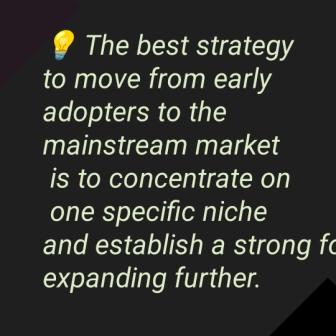
Crossing The Chasm
Introduction
Launching a new product—especially something innovative or techy—is hard. You get a few early fans who “get it”… but then growth stalls. Mainstream customers just don’t bite.
Sound familiar?
That’s the exact problem Geoffrey Moore tackles in Crossing the Chasm. This isn’t some fluffy marketing theory—it’s a real-world roadmap for getting your product out of “startup limbo” and into the hands of the people who actually pay the bills: the mainstream market.
Moore explains that there’s a huge gap—a chasm—between early adopters (who love trying new things) and the early majority (who want proven solutions).
And if you don’t bridge that gap the right way, your product might never take off.
He breaks down how to:
- Find a beachhead market and dominate it
- Position your product so it feels like a must-have
- Build a full solution mainstream buyers can trust
- Launch in a way that makes your growth stick
If you’re building a product, running a startup, working in marketing, or just curious why some great ideas take off and others don’t—this book is a must-read.
Reading this summary will give you the core ideas, but trust me: once you see how powerful the strategy is, you’ll want the full book on your shelf.
It’s a classic for a reason.

Click on the Tabs Below to Read Crossing The Chasm Summary
Crossing the Chasm teaches how tech startups can successfully move from early adopters to the mainstream market by narrowing their focus, dominating a specific niche, and using it as a launchpad to cross the risky “chasm” between early enthusiasm and mass adoption.
Who Should Read Crossing The Chasm?
Crossing the Chasm is for founders, marketers, and product managers in tech startups, especially those working on innovative or disruptive products.
It’s also highly useful for investors, startup coaches, and anyone involved in launching new technology into the market.
Why should they read it?
Building a great product isn’t enough—most startups fail not due to bad tech, but because they can’t get beyond early adopters.
This book explains the exact moment where most startups stall (the “chasm”) and gives a clear roadmap to move from a small group of visionary users to the much larger (and more profitable) mainstream market.
It helps you avoid wasting time, money, and momentum on the wrong customers, and teaches you how to build lasting traction.
If you want your product to become the next big thing—not just a “cool idea”—you need this book.
Chapter 1 The High-Tech Marketing Illusion
A lot of new inventions — especially tech stuff — look like they’re going to take off, but then they flop. It’s kind of like how some musicians go viral for a week but disappear a year later. Same energy.
Big idea of this chapter:
Why tech startups get fooled early on.
Moore starts by introducing this concept:
The Technology Adoption Life Cycle (TALC)
This is the core concept in this Chapter. Moore builds on a curve that’s been around for years — originally used in agriculture and sociology — and adapts it for marketing new tech.
The customer groups he introduces are:
1. Innovators (Tech Enthusiasts): Love new gadgets. They don’t need it to work perfectly. They enjoy the process of tinkering and discovering.
Example: Someone who lined up at midnight to get the first VR headset or tried ChatGPT before it went mainstream.
2. Early Adopters (Visionaries): They aren’t just playing — they see how the tech could give them a strategic edge. They’re often entrepreneurs, consultants, or executives who want to be first to win by using something powerful and new.
Example: A company leader who uses AI before their competitors to automate support and save money.
3. Early Majority (Pragmatists): Very different mindset. They want proven, reliable solutions. They don’t like taking risks, and they want case studies, references, and real-world results.
Think: A bank or school that only adopts new tech after hearing “it works for others like us.”
4. Late Majority (Conservatives): Even more skeptical. They adopt something only when it’s everywhere and hard to avoid.
Example: People who just recently switched to using Zoom or mobile banking during COVID.
5. Laggards (Skeptics): Usually adopt last — or never. Often resistant to change altogether.
When a startup makes a brand-new gadget, app, or software, the first few people who buy it are usually tech lovers.
These folks love being first. Think of your friend who had Bitcoin in 2012, or the guy who bought Google Glass when nobody else would be caught dead wearing them.
Geoffrey Moore calls these people Innovators.
Then comes the group Moore calls — Early Adopters. These people aren’t just obsessed with tech. They’re big-picture thinkers.
They’re the kind of people who look at something new and say, “This could change the world.”
Now here’s where the illusion happens…
Startups see these people (early adopters) buying their product and they think:
“YES! We’ve made it! This is going viral!”
But Moore says, “Hold on… that’s a trap.”
Because the next big group of customers — the Early Majority — are totally different animals.
The big misunderstanding: Not all customers are alike.
Moore explains that the people who come after the Innovators and Early Adopters — the ones who could really make your business boom — don’t buy for the same reasons.
Early Adopters are okay with rough edges.
The Early Majority want something safe, reliable, and already proven.
Think of it like this:
Let’s say someone builds a new electric scooter company. The first people who buy are the adventurous city dwellers — young professionals who think it’s cool and green.
They’re willing to test it out even if the app crashes sometimes.
But if the company thinks that means everyone will buy, they’re wrong. The average commuter — say, your uncle or a working mom — isn’t going to risk her morning routine on something that’s glitchy or needs five updates a week.
She wants to see that it works, that it’s easy, and that other regular people are already using it.
Why this matters so much
Moore says this misunderstanding is why so many products die early.
Companies rush ahead thinking they’ve won, but they haven’t built the kind of trust, support, and simplicity the average person needs.
That’s the illusion: thinking early buyers represent the whole market.
Example: Smartwatches
Remember when smartwatches first came out? The first people to buy them were fitness junkies and tech fans.
They loved tracking steps and heart rates. But normal folks? They were like, “Wait… why do I need this when I have a phone?”
It wasn’t until companies like Apple made the watch sleek, reliable, and useful in everyday life (like calling, messaging, health alerts) — that the mainstream crowd started buying. That’s the difference Moore is talking about.
Moore is saying: Don’t get too excited about the first fans of your product. They’re just the warm-up act.
If you want your business to really grow, you need a plan for reaching everyday, practical people — and that’s a whole different ball game.
The Cracks and the Chasm
Moore explains that the transitions between each of these groups aren’t smooth. There are “cracks” between each stage where startups can lose momentum — because the next group doesn’t respond to the same pitch.
But the biggest and scariest gap is between Early Adopters and the Early Majority.
That’s what he calls “The Chasm.”
Early Adopters want change.
The Early Majority want stability.
This creates a major conflict:
The exact things that excite your early fans can scare away your mainstream market.
What Companies Get Wrong
Moore points out a common mistake:
Startups use the same marketing playbook that worked for Early Adopters to try and attract the Early Majority — and it fails.
Because they’re talking about vision, innovation, disruption, and features… when the Early Majority wants to hear about reliability, support, and case studies.
He gives examples of failed companies that had amazing early success — huge press, awards, funding — but couldn’t make it past this early group.
Their product wasn’t ready for the mainstream, or their marketing didn’t build trust.
It’s Not Just About the Product
This is subtle but important.
Moore argues: it’s not just about having a great product — you need the right marketing strategy, positioning, and focus to get the mainstream market to adopt your innovation.
Otherwise, you’ll fall into the chasm.
Quick Takeaway:
Early success with tech products is misleading. Just because early adopters love your product doesn’t mean the majority will. You need a different mindset, message, and plan to “cross the chasm” between tech lovers and everyday buyers. And if you don’t cross it right, you’ll stall or fail.
Chapter 2: High-Tech Marketing Enlightenment
This chapter is where Moore goes from just pointing out the problem to giving us a better understanding of how to actually think about high-tech marketing.
Remember the Chasm?
Moore now explains why crossing it is so hard and how we can start to rethink marketing to different customer types.
He’s basically saying:
Stop trying to sell to everyone the same way. The people on either side of the chasm don’t just want different things — they speak different languages!
So, what does he do here? He unpacks how each group thinks, and how you should adjust your approach if you want your product to survive.
The Five Customer Groups (Again, but Deeper)
He revisits the five groups from Chapter 1, but this time, he gives more insight into how they behave and what they care about when deciding to buy a product.
Here’s a breakdown — think of it like personalities in a WhatsApp group:
1. Innovators (Tech Enthusiasts)
These are the gadget geeks.
They love to try new things, even if they break.
They’re willing to figure things out themselves.
But: there aren’t many of them, and they don’t influence the masses.
Example:
Think of someone who installed beta software just to test features before the public.
2. Early Adopters (Visionaries)
These are dreamers with budgets. They want breakthroughs.
They’re willing to take risks if they believe your product gives them a competitive edge.
But: they want custom solutions, not off-the-shelf stuff.
Example:
A hospital director who says, “If this AI tool can predict patient outcomes, I want it — even if it’s early.”
They’ll fund the pilot — but only if it helps them leapfrog the competition.
Important note: Startups often fall in love with these guys. They say nice things. They buy early. But they don’t represent the mainstream market.
3. Early Majority (Pragmatists)
These folks are practical, not risky.
They want proven products from trusted companies.
They need support, references, and stability.
Example:
A school that won’t buy your new learning app until other schools have used it successfully — and there’s tech support if something goes wrong.
4. Late Majority (Conservatives)
They’re skeptical and slow to adopt.
They’ll only buy if it’s become a standard and they feel left behind.
5. Laggards (Skeptics)
They actively resist change.
Usually won’t buy unless they’re forced to.
Here’s the Enlightenment Part:
Moore says the key to success isn’t to try to jump from Innovators → Everyone.
You need to go step-by-step:
Win over the Early Adopters → then carefully plan to win the Early Majority.
The mistake is assuming these groups will automatically follow one another.
They won’t — unless you make it happen intentionally.
He introduces this mental shift:
Instead of going “horizontal” (trying to sell a little to every industry), go vertical — focus on one market segment, dominate it, and use it as a base to cross the chasm.
Real-World Analogy:
Imagine you opened a new gym with high-tech equipment that tracks your form and progress. The first people to sign up are fitness nerds and trainers (Innovators).
Then you get a few ambitious influencers who want to promote cutting-edge health ideas (Early Adopters).
Now, you assume everyone will come. But regular people are like:
“Will it really help me lose weight? What if it’s complicated? Who else is using it?”
If you keep using the same pitch — “It’s futuristic and new!” — they’ll back off.
Instead, you need to say:
“Look, this mom of 3 lost 15 pounds in 6 weeks — and here’s how she did it, step by step.”
That’s how you cross the chasm.
Quick Takeaways:
Moore wants you to stop thinking linearly and start thinking strategically about which group you’re targeting — and how.
Early tech buyers are not like mainstream customers. So don’t assume one leads to the other unless you deliberately build that bridge.
Chapter 3: The D-Day Analogy
Here’s the big idea:
Crossing the chasm is like planning a military invasion.
And Moore doesn’t just say that for drama — he means it strategically. He compares your startup’s market entry to D-Day, the Allied forces’ invasion of Normandy in WWII.
Sounds intense, right? But stay with me — it actually makes so much sense.
You’ve built a great product.
You’ve gotten some early adopters — the visionaries — excited about it.
But now… you’re stuck. The mainstream market is not buying.
Why? Because they’re cautious. They want proof, stability, and a whole solution — not just cool tech.
So what’s the D-Day game plan?
Moore says: Don’t try to storm the whole beach at once. That’s a recipe for failure.
Instead, focus all your resources on one narrow point — one specific beachhead — and win there decisively.
That beachhead = a very specific target market.
You can’t go broad. You can’t try to sell to banks, schools, hospitals, and retail stores at the same time.
You pick one use case, one type of customer, and dominate.
Just like the Allies picked Normandy — not all of Europe — for their entry point.
Why this matters:
You’re trying to get the Early Majority on board, right? These folks are pragmatic. They don’t want to be your experiment. But once they see a version of themselves using your product successfully, they’ll listen.
Moore calls this the “beachhead strategy.”
Example:
Let’s say you’ve built an AI writing tool. You’re tempted to market it to:
- Authors
- Students
- Marketers
- Bloggers
- Lawyers
- Doctors
But Moore says: No. That’s dangerous.
Instead, pick one vertical — let’s say: Content marketers at small agencies in Nigeria.
Build the exact features they need. Get testimonials from them. Solve their pain points completely.
That becomes your beachhead.
Once you win that segment, it becomes your proof point. Then you expand.
What happens if you don’t do this?
Moore says startups that try to go broad usually get a little interest from a lot of places, but not enough traction from any one place. So they slowly die out. They fall into the chasm and never come back.
Quick Takeaways:
- The Chasm between Early Adopters and Early Majority is dangerous.
- To cross it, use a D-Day-style invasion strategy:
- Focus on one specific segment.
- Deliver a whole product solution.
- Win there before expanding.
- Avoid the trap of spreading yourself too thin.
In a battle for market adoption, focus isn’t just helpful — it’s survival.
Chapter 4: Target the Point of Attack from Crossing the Chasm.
This is where Moore gets super practical and tells us exactly how to pick that one perfect market segment to focus all your energy on — your “point of attack.”
Why is picking the right target so important?
Remember from Chapter 3, crossing the chasm is like a military invasion, and you cannot attack everywhere at once. You need to pick a beachhead — a specific market segment — where you can win decisively.
Moore emphasizes that choosing the wrong target is like launching your troops in the wrong place — it’s costly and can lead to defeat.
What makes a good “point of attack”?
Moore lists a few criteria you should use to pick your ideal target:
1. Beachhead market must be focused and specific
Don’t say “small businesses” or “everyone who uses software.” Instead, it should be a narrow, well-defined group with shared characteristics and needs.
2. There must be a compelling reason to buy
The pain point in this segment must be strong and urgent — something your product uniquely solves.
3. There should be a whole product solution available or easily built
Early Majority buyers want the full package — the product, support, training, and everything they need to succeed.
4. The market must be accessible
You should be able to reach and sell to this group with your current resources — meaning you can market and distribute effectively.
5. There should be a dominant player opportunity
In this niche, you want to be the obvious choice — not just one option among many.
The “Bowling Alley” concept
Moore introduces the idea of the Bowling Alley:
Imagine each niche market is like a bowling pin. You knock down one pin (your beachhead), and then the momentum helps you knock down the next pins (adjacent markets).
So your initial target isn’t just about winning that market alone, but creating momentum for the rest.
Example:
Let’s say you built an advanced CRM tool for sales teams. Instead of pitching it to every business, you choose a niche:
Real estate agents in Lagos, Nigeria.
Why? Because they:
- Face unique challenges with managing client leads.
- Have a strong pain point around follow-up.
- Can be reached through local real estate associations.
- Are large enough to make an impact but small enough to focus on.
You focus on making your product perfect for this group — including local support, language, and training.
Once you dominate real estate agents in Lagos, you move to “knock down” adjacent segments, like insurance brokers or car dealerships.
What mistakes do companies make?
Going after big markets without focus, leading to diluted efforts and no clear wins.
Selling a product that’s not a whole solution — for example, selling just the software without the training and support that mainstream customers expect.
Targeting groups that don’t have a strong or urgent pain point.
Quick Takeaways:
- Pick a narrow, focused niche where your product solves a real, urgent problem.
- Make sure you can offer the whole product solution — not just the technology.
- Ensure the market is reachable with your sales and marketing efforts.
- Dominate this beachhead to gain momentum for expansion.
So basically, this Chapter is your strategic compass for the chasm-crossing war. It helps you focus your resources on the right target, not just the biggest or most obvious one.
Chapter 5: Assemble the Invasion Force
This chapter is all about getting your team and resources lined up so you can storm that beachhead you picked in Chapter 4.
The big idea of this chapter:
You’ve chosen your target market — now you need the right people, partners, and strategies to actually win in that market.
Think of it like this: you wouldn’t send a bunch of untrained civilians into a battle and expect victory.
You need a well-coordinated invasion force.
What does the invasion force include?
1. Sales Team
Moore stresses that selling to the mainstream market is very different from selling to early adopters.
Early adopters love innovation and can handle some rough edges.
Early Majority want solutions, not experiments.
So, your sales team needs to be skilled at handling risk-averse buyers and explaining the whole product benefits.
2. Marketing
Your marketing must speak the language of pragmatism, showing proven results and minimizing perceived risk.
Case studies, testimonials, and references become weaponized proof points.
3. Partners
Moore points out that to win mainstream customers, you often need partners — companies who provide complementary products, services, or distribution channels.
For example, if you sell software, you might partner with a hardware provider or an integration company.
4. Customer Support and Services
Early Majority customers expect support, training, and sometimes customizations.
Having a strong support team helps build trust and lowers the perceived risk.
Why is this so important?
Because crossing the chasm means changing the way you do business. It’s not enough to have a great product; your whole company has to shift focus to serve the mainstream customer’s expectations.
Example:
Think about Apple in the early 2000s with the iPod:
- They didn’t just launch the device.
- They partnered with iTunes to provide an easy music store (partners).
- Their marketing focused on simplicity and lifestyle benefits (marketing).
- They provided customer support through Apple stores (support).
- They trained salespeople to explain the iPod to mainstream users (sales team).
That combination of forces helped Apple cross from early adopters to the mass market.
What happens if you don’t assemble the invasion force properly?
Your product may get some early wins, but it won’t scale or gain momentum. You’ll fall short on the expectations of the mainstream market and fail to cross the chasm.
Quick takeaways:
- Crossing the chasm requires a different go-to-market approach.
- Assemble a strong sales team trained for pragmatic buyers.
- Build marketing that provides proof and reduces risk.
- Partner with companies that complement your product.
- Provide excellent customer support and services to reassure customers.
Basically, Moore is saying: if you want to win the big war, don’t just build a product — build an entire invasion machine.
Chapter 6: Define the Battle
This chapter is where Moore dives into how to shape your messaging and positioning so your target market gets it and chooses you over competitors.
Why is defining the battle important?
You’ve picked your market (Chapter 4), assembled your invasion force (Chapter 5), but if you don’t clearly explain why your product is the best solution, you’ll lose the fight.
Moore says the battle is all about perception. The mainstream customer wants to quickly understand:
- What problem does your product solve?
- Why are you the safest, easiest, best choice?
- How do you reduce their risk?
What does “defining the battle” really mean?
It means positioning your product in a way that resonates with your target niche. You have to speak their language, frame the problem from their perspective, and make it crystal clear why your solution is the one to CHOOSE.
Key elements of positioning
Moore introduces a positioning template that covers:
For [target customer]
Be specific about who you’re talking to.
Who are dissatisfied with [current solution]
Acknowledge the pain or gap they have now.
Our product is a [product category]
Help them understand what type of product you are.
That provides [key benefit]
What big result or benefit do you deliver?
Unlike [main competitor or alternative]
Clarify how you’re different or better.
We provide [unique differentiation]
What unique features or approach set you apart?
Why is this so powerful?
Mainstream customers rely on category labels to quickly understand where your product fits. If you invent your own category or confuse them, they get scared.
Moore stresses you must choose an existing category and clearly show why you’re the best in it.
Example:
Think about the iPhone when it launched:
Target customer: Mobile phone users who want an all-in-one device.
Dissatisfaction: Phones were hard to use or didn’t have good web access.
Product category: Smartphone.
Key benefit: Easy-to-use touchscreen with internet and apps.
Main competitor: Blackberry and Nokia phones.
Unique differentiation: Intuitive UI and seamless app ecosystem.
Apple defined the battle so users knew exactly why the iPhone was the best choice.
What happens if you don’t define the battle?
Customers don’t understand what you do or why you matter.
They default to established competitors.
Your marketing dollars are wasted because your message doesn’t connect.
Quick takeaways:
- Positioning is critical to crossing the chasm.
- Use a clear, simple template to explain who you serve, what problem you solve, and why you’re the best choice.
- Use familiar product categories to reduce confusion and risk.
- Highlight your unique differentiation clearly.
- Your whole marketing and sales message must reflect this positioning consistently.
Chapter 7: Launch the Invasion
This is the big moment where all your planning and preparation get put into action. You’re officially storming the beachhead!
What does “launch the invasion” really mean?
It’s about executing your go-to-market plan with full focus and commitment. You don’t hold back; you commit every resource to winning your target market.
Key points Moore makes in this chapter:
- Focus all efforts on the beachhead market
- Don’t get distracted by other segments or try to be everything to everyone. This is about dominating one niche completely.
- Use a “single-minded, focused attack”
Your marketing, sales, customer support, and product updates all push the same message and solution. - Leverage references and word-of-mouth
Early mainstream customers want proof that the product works for people like them. Use happy customers as references to build credibility. - Plan for rapid scaling
Once you win your beachhead, be ready to move fast and expand into adjacent markets (the “bowling alley” strategy from Chapter 4). - Measure everything
Track sales, customer feedback, and market response closely to adjust tactics quickly.
Example:
Think about Tesla launching the Model S:
They focused first on the luxury electric car niche — early mainstream customers who could afford it and cared about performance and innovation.
Tesla’s marketing was laser-focused on this group, showing off real customers, performance stats, and glowing reviews.
They didn’t try to immediately sell to everyone; they conquered this niche first before expanding.
They tracked customer satisfaction carefully to improve the next versions.
What can go wrong if you don’t launch properly?
Spreading too thin by chasing multiple markets leads to weak presence everywhere.
Mixed messaging confuses customers.
Slow scaling loses momentum and lets competitors jump in.
Quick takeaways:
- Commit fully to your chosen beachhead — don’t dabble.
- Align your whole company around a single, focused message.
- Use references to build trust and credibility with pragmatic buyers.
- Be ready to scale fast after winning your first market.
- Keep measuring and adapting.
Here the things you need to start doing right now to implement the strategies in Crossing The Chasm
1. Choose a Specific Beachhead Market (Start Narrow)
You can’t win the whole market at once—start with one specific niche where you can dominate first.
Step-by-step Instructions:
Week 1: Identify your options
List 3–5 market segments that could benefit most from your product.
Week 2: Score and select one niche
Use Geoffrey Moore’s segment scoring framework (size, pain, accessibility, competition, alignment with your strengths).
Choose the one with:
- A pressing need for your product
- Few strong competitors
- Clear communication channels (forums, associations, blogs)
Week 3: Create a beachhead profile
Write down:
- Who the customers are (job title, industry, problem)
- Where they hang out (LinkedIn groups, Reddit, conferences)
- What they care about
Potential Challenges:
Fear of limiting your market: But remember, winning a small market builds momentum and proof.
Unclear market data: Talk to real potential customers, don’t rely only on online research.
Timeframe: 2–3 weeks
Measurable Metrics:
- Chosen segment documented clearly
- Identified top 3 customer needs in that segment
- Created list of at least 20 leads in that niche
2. Create an Ideal Customer Profile (ICP)
Know exactly who you’re selling to in your beachhead market.
Step-by-step Instructions:
Week 1: Interview 5–10 target users
Ask them:
- What problem is most painful for you right now?
- What solutions have you tried?
- What would a perfect solution look like?
Week 2: Define your ICP
Create a 1-page profile that includes:
- Job title, industry, company size
- Key pain points
- Buying process and decision-makers
Potential Challenges:
Getting interviews: Offer a small gift (e.g., $10 gift card) or leverage warm intros to get conversations.
Interviewing wrong users: Stay within your chosen beachhead market.
Timeframe: 2–3 weeks
Measurable Metrics:
- 1-page ICP document createdAt least 5 interviews completed
- Specific language from customers recorded for use in messaging
3. Craft a Compelling Value Proposition
Speak your customer’s language, not yours.
Step-by-step Instructions:
Week 1: Use the “Before–After–Bridge” formula
For your ICP, write:
- Before: What their life looks like without your product
- After: What life looks like with your product
- Bridge: How your product makes it happen
Week 2: Test your message
Post 3 different variations on social media, run them as email headlines, or A/B test on your landing page.
Potential Challenges:
Using jargon: Use phrases from your customer interviews, not your internal team.
Low engagement in tests: Run multiple small experiments and refine.
Timeframe: 2–3 weeks
Measurable Metrics:
- 3 value prop versions written and tested
- Landing page conversion rate improves
- Email open/click rates increase
4. Recruit Reference Customers
Find 3–5 early customers who love your product and are willing to tell others.
Step-by-step Instructions:
Week 1: Identify super-happy users
Look for customers who already gave great feedback or stayed loyal.
Week 2: Ask for testimonials and referrals
Offer something in return (a discount, early access, etc.).
Week 3: Publish and promote
Put testimonials on your website and share on social media.
Potential Challenges:
Fear of rejection: Most happy customers are glad to help—you just need to ask.
Legal/approval delays (especially in B2B): Get written permission or anonymize if necessary.
Timeframe: 3–4 weeks
Measurable Metrics:
- At least 3 testimonials gathered
- Referrals begin converting to new leads
- Website conversions improve with social proof
5. Focus Your Resources on One Use Case
Solve one problem really well instead of trying to do everything.
Step-by-step Instructions:
Week 1: Audit your product’s current features
Ask: Which features are actually being used? Which solve the core problem for our ICP?
Week 2: Prioritize development and marketing on one core use case
Shift your team’s messaging, onboarding, and sales efforts around this.
Week 3+: Track results
See if focus improves customer satisfaction and reduces churn.
Potential Challenges:
Team resistance to dropping features: Remind them that clarity wins over complexity.
Losing edge cases: That’s fine—you’re optimizing for mainstream adoption.
Timeframe: 1 month
Measurable Metrics:
- Feature usage up for focused area
- Customer onboarding time drops
- Support tickets around the main use case decline
6. Build an Aligned Sales and Marketing Strategy
Make sure sales and marketing are telling the same story to the same audience.
Step-by-step Instructions:
Week 1: Bring sales and marketing together
Create a shared one-page “chasm playbook” that includes:
- ICP
- Messaging
- Customer journey
- Objections and answers
Week 2–3: Align campaigns and outreach
Ensure that ads, blog posts, sales calls, and follow-ups all reflect the playbook.
Month 2+: Refine together monthly
Review results and tweak based on what’s working.
Potential Challenges:
Misaligned goals (leads vs. deals): Create shared KPIs.
Communication gaps: Hold weekly standups between both teams.
Timeframe: 1–2 months
Measurable Metrics:
- Sales cycle time shortens
- Lead-to-customer conversion increases
- Consistency across campaigns improves
7. Measure and Optimize Your Chasm-Crossing Progress
Track whether you’re actually gaining traction in the mainstream.
Step-by-step Instructions:
Month 1: Pick 3 key metrics
Market penetration
Reference customers
Conversion rates
Month 2: Set targets
e.g., “Get 5% of [niche market] to sign up in 3 months”
Month 3–6: Monitor monthly
Use dashboards (Google Sheets, Notion, analytics tools)
Review trends and adjust efforts
Potential Challenges:
Tracking the wrong metrics: Focus on quality adoption, not vanity metrics.
Slow progress: Use feedback loops to refine messaging, channels, or onboarding.
Timeframe: Ongoing
Measurable Metrics:
- Conversion rates improve
- More mainstream (non-technical) users are adopting
- Revenue or retention increases in your target niche
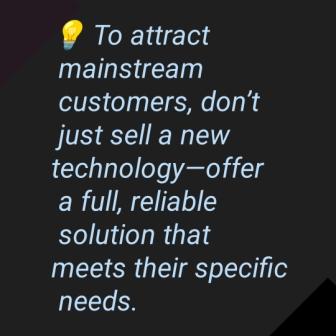
Book Details
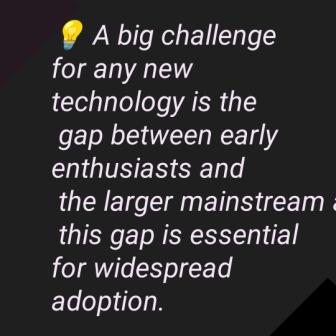
Crossing the Chasm Quiz
-
Start Crossing The Chasm Quiz


